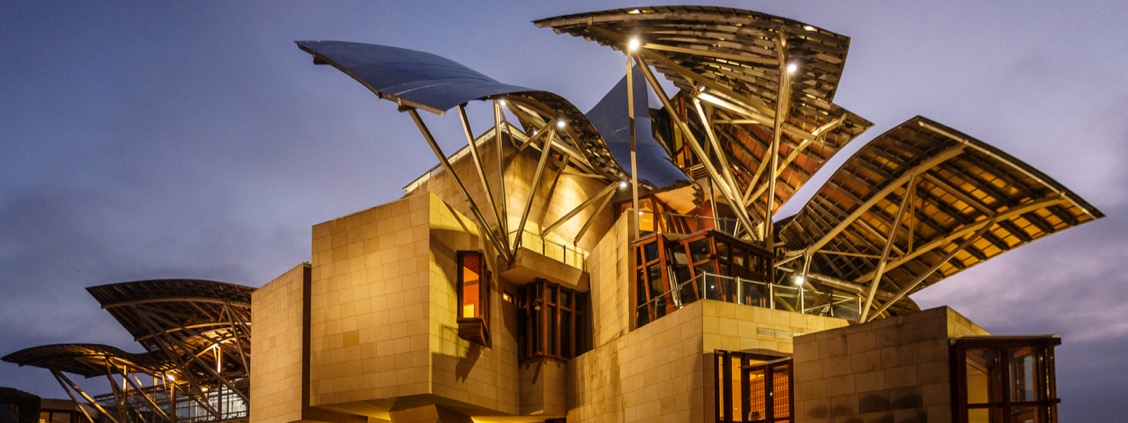Hotel Marqués de Riscal
last update: 22 December 2022
Our first visit was in September 2021, and our second visit in December 2022. The report below starts with our visit in 2021, and continues with a quick update from our visit in December 2022.
There is a second part to this review that covers how the "ciudad del vino" was conceived and built.

The 5-star Hotel Marqués de Riscal is probably the last thing you’d expect to see in Spain’s Elciego wine region.
Elciego is a small town in the Rioja wine region in the very southern part of the Basque Country. The area actually produces what is called Rioja Alavesa, as opposed to Rioja Alta and Rioja Baja (now called Rioja Oriental). The Rioja Alavesa is known to age well, thanks to a must with a marked acidity and powerful tannic structure.

It's important to note that there is a difference between La Rioja as a Spanish province and autonomous community and Rioja as a wine region with a denominación de origen calificada (DOCa), the highest category in Spain wine regulations. In fact Rioja wine is made from grapes grown in three different autonomous communities, La Rioja, Navarre, and the Basque province of Álava. So Elciego produces Rioja wine, but is located in the Basque province of Álava, and not the autonomous community of La Rioja. The distinction between La Rioja province and the Rioja wine region is not easy to understand. For example, the part of Rioja Baja north of Ebro River is in the autonomous community of Navarre, whereas the part of Rioja Alta that encroaches north of the Ebro actually is still part of the autonomous community of La Rioja. But the entire area of Rioja Alavesa is in the Basque Country.
Elciego is a village of about 1,000 people, but it's home to seven different bodegas (wine producers), i.e. Luberri Monje-Amestoy, Bodegas Murua, Bodegas Muriel, Bodegas Aladro, Bodega Pago de Larrea, Bodegas Fos, and of course the Marqués de Riscal.
Note: This webpage covers our visit to the Hotel Marqués de Riscal, but there are three additional webpages that are related to this, namely:-
The New Temples of Wine - Marqués de Riscal might be today's best known example of "starchitect" architecture in a Spanish vineyard, but it was certainly neither the first, nor the last.
The History of Rioja Wine - how did Rioja become the first wine to be awarded the denoninación de origen calificada (denomination of qualified origin or DOCa), the highest category in Spanish wine regulations?
Making Rioja Wine - we follow a visit to the winery of Marqués de Riscal, and look at how Rioja is made.
Ciudad del Vino
Created in 2006 the City of Wine is a complex that includes both early and modern cellars, along with vineyards, and a leisure complex set in the Hotel Marqués de Riscal, an emblematic building designed by architect Frank Gehry and inaugurated in 2006 by King Juan Carlos I.

Here we can see the entire site of the hotel and winery. The entrance to the site is on the left, where only guests at the hotel can enter with their car. Just under the word "Hotel" there is the reception building for the guided tours, and the shop. Just above the word "Marqués" there is the "El Palomar" winery built in 1883 (this was the main building for our visit). The other buildings house the main winery, with ageing, bottling, storage, shipping, etc. For example, we saw their Próximo wine which is designed as a "sin crianza" medium intensity young Rioja with a more light ripe-fruity taste (93% Tempranillo). Oddly, Próximo does not appear on the Marqués de Riscal website. And we also saw pallets of the Champagne Laurent-Perrier being unloaded, because the Marqués de Riscal is the distributor in Spain.
We will first review our stay at the hotel, then look at the hotel building itself, and finally we will look a little bit more at the Marqués de Riscal as an example of a Rioja wine (including our visit to the bodega).
Arriving in Elciego in September 2021
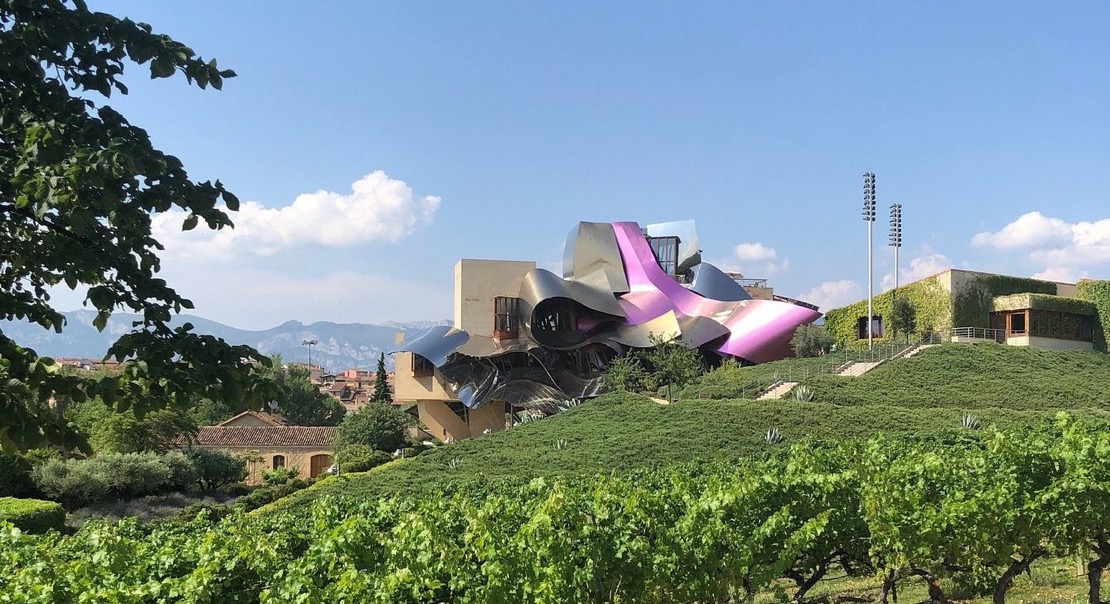
Unfortunately the car navigation system took us to what was probably the old entrance to the winery, and the local signposts were not that useful, but Elciego is a small village, so it did not take long to find the real entrance. On top of that you can see the hotel from some distance away, so you can't really get lost.
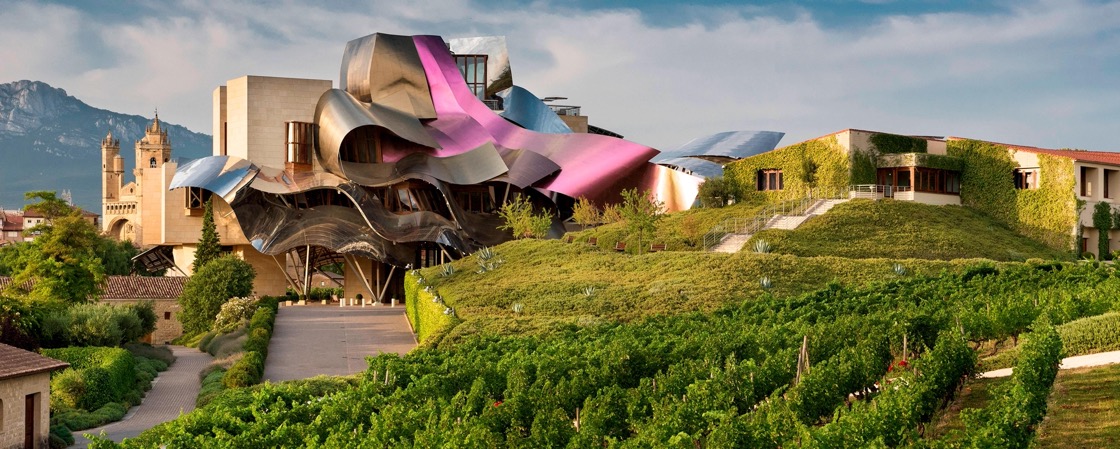
So you can drive up to the hotel entrance, and the porter will take you bags, park you car, and give you your keys back.
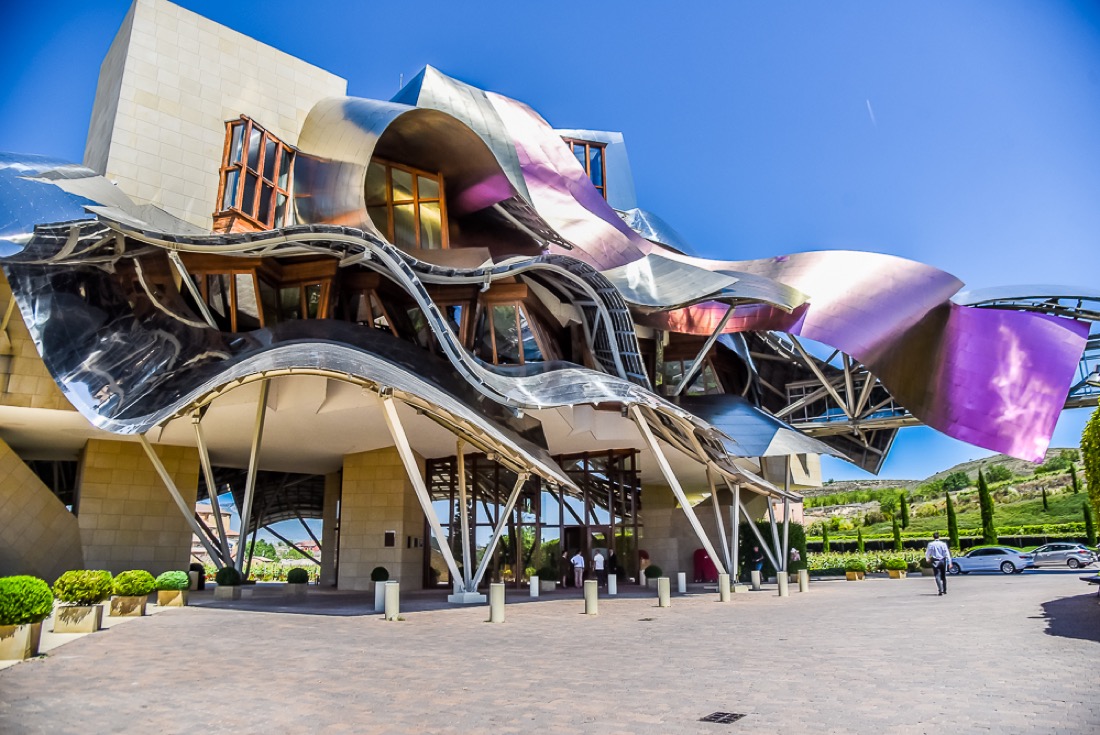
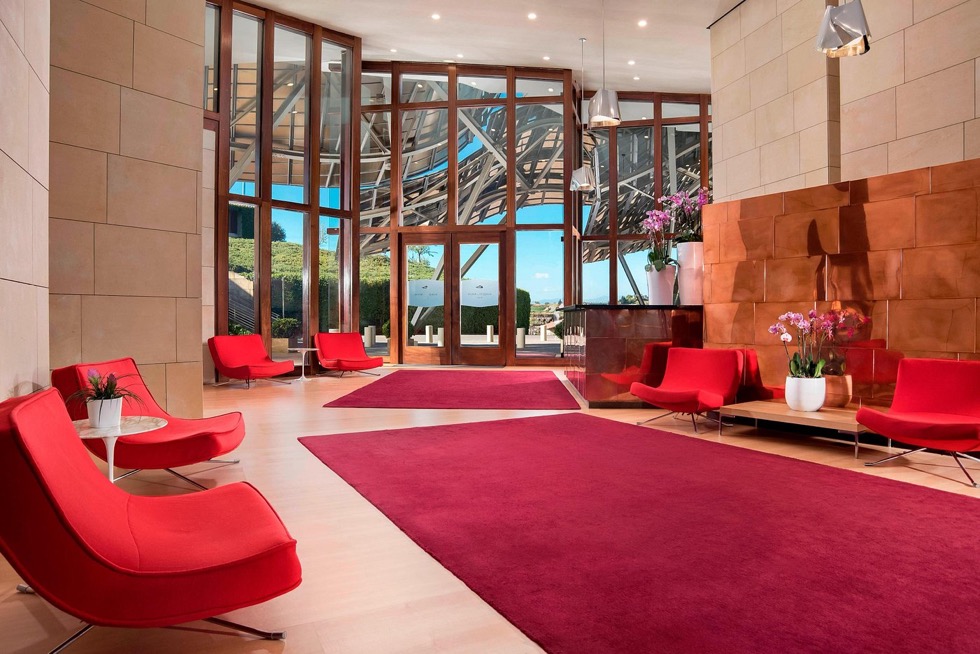
Check-in was efficient, and the porter did his job, but he did not introduce our room, i.e. explain the TV, Internet access, A/C, etc.
Our room
One of the first things to decide when booking is what type of room to book. There are really just three options, a room inside the main hotel building or a room in what they call the Spa building. There are two types of rooms in the Spa building, either with a view over the vineyards, or as they define it, with a view over the village. Below we can see the Spa building, and the rooms with the view over the village. And have a look at those 961 photovoltaic modules on the roof generating 312.3 kWp (representing up to 30% of the hotels energy consumption).
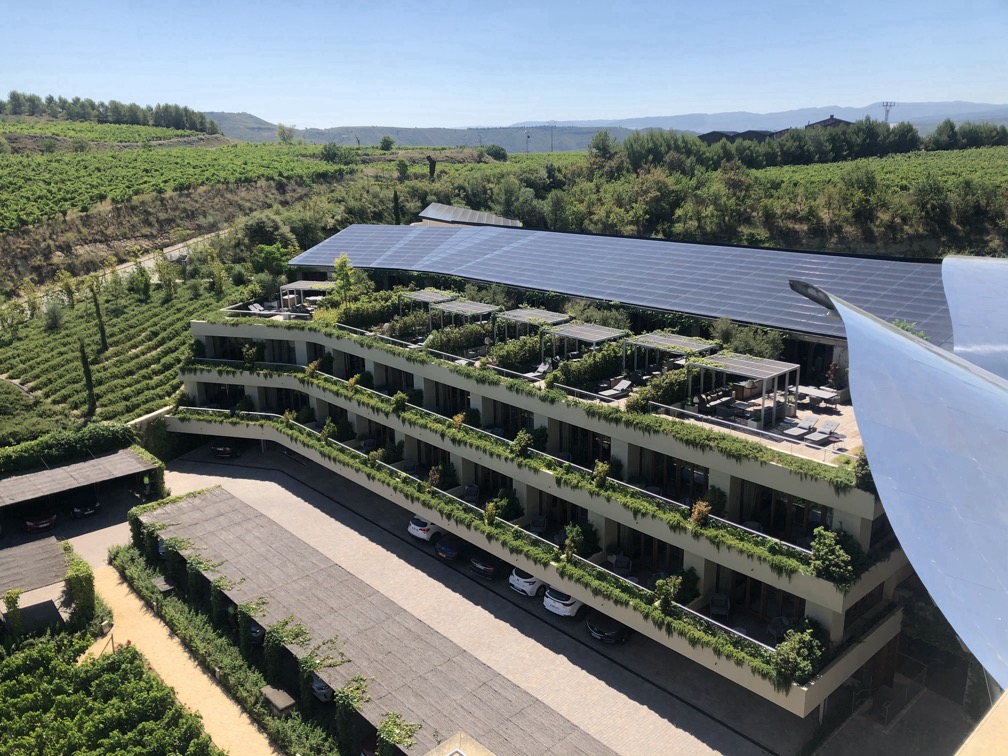
The reality is that rooms with a view over the village also have a view towards the Gehry building. We booked a Premium Spa Room, which was about 40 square meters, and had a balcony with views over the medieval town, backed by the Sierra de Cantabria mountain range, and to the left the Gehry façade. The room had all the usual services of a typical 5-star hotel, e.g. 55" flatscreen TV, minibar, complimentary water, daily housekeeping service, a nightly turndown service, a good sized in-room safe, and tea and Nespresso coffee making facilities. Guests also enjoy free access to the Spa and a complimentary scheduled guided tour of the Marqués de Riscal winery.
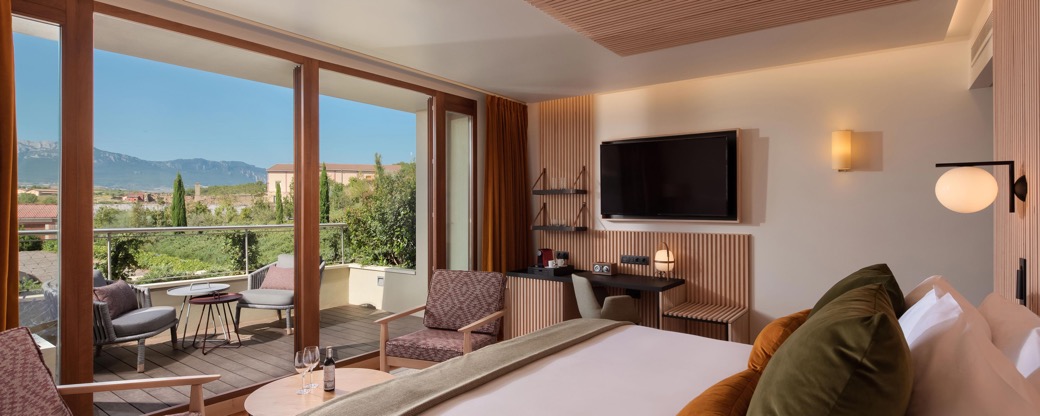
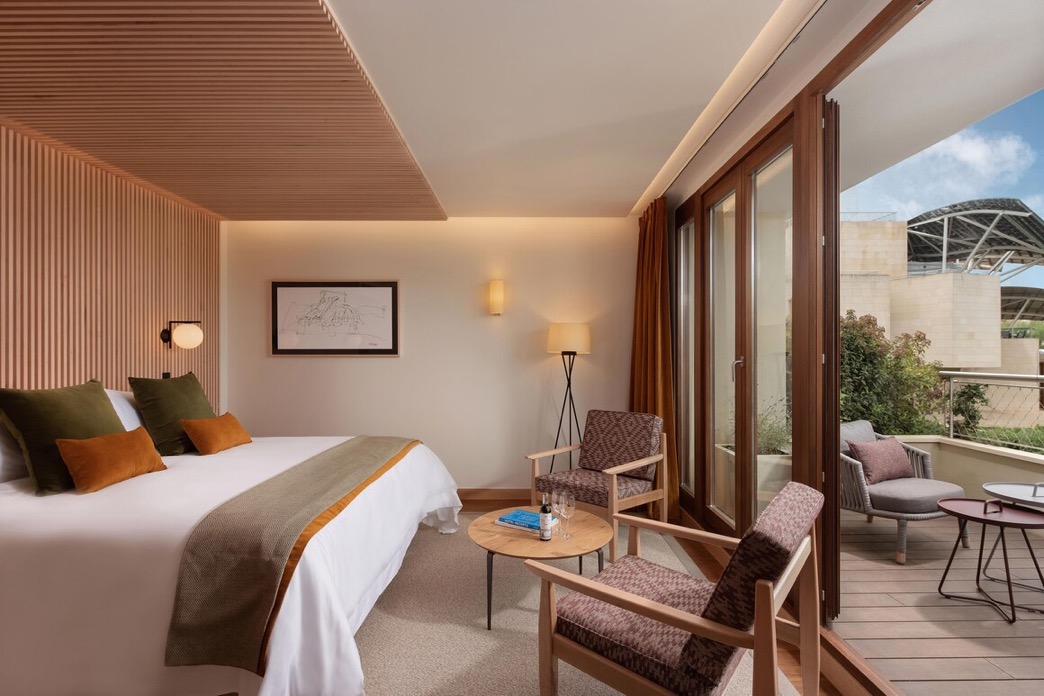
There was a spacious bathroom with Italian marble, and a bath and separate walk-in shower. The amenities include plush bathrobes and slippers, a makeup and shaving mirror, a salon-style hairdryer, and Caudalie products.
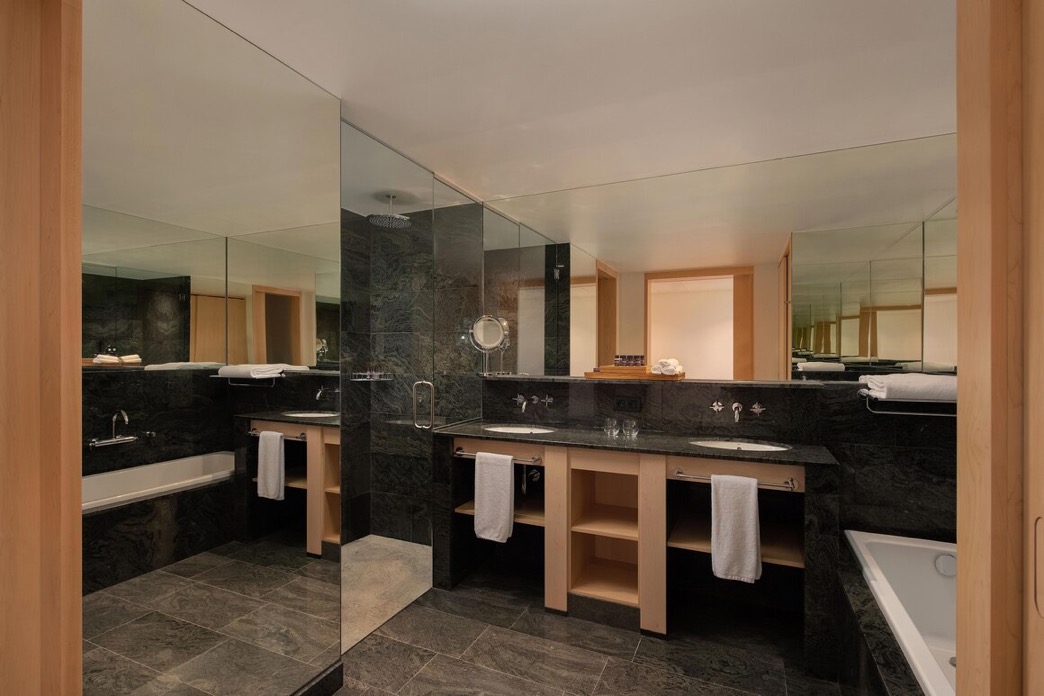
A very positive point was that, presumably because of COVID, the throw over the bed, and the decorative cushions had been removed.
Below we have the exact view of the Gehry building from our terrace.
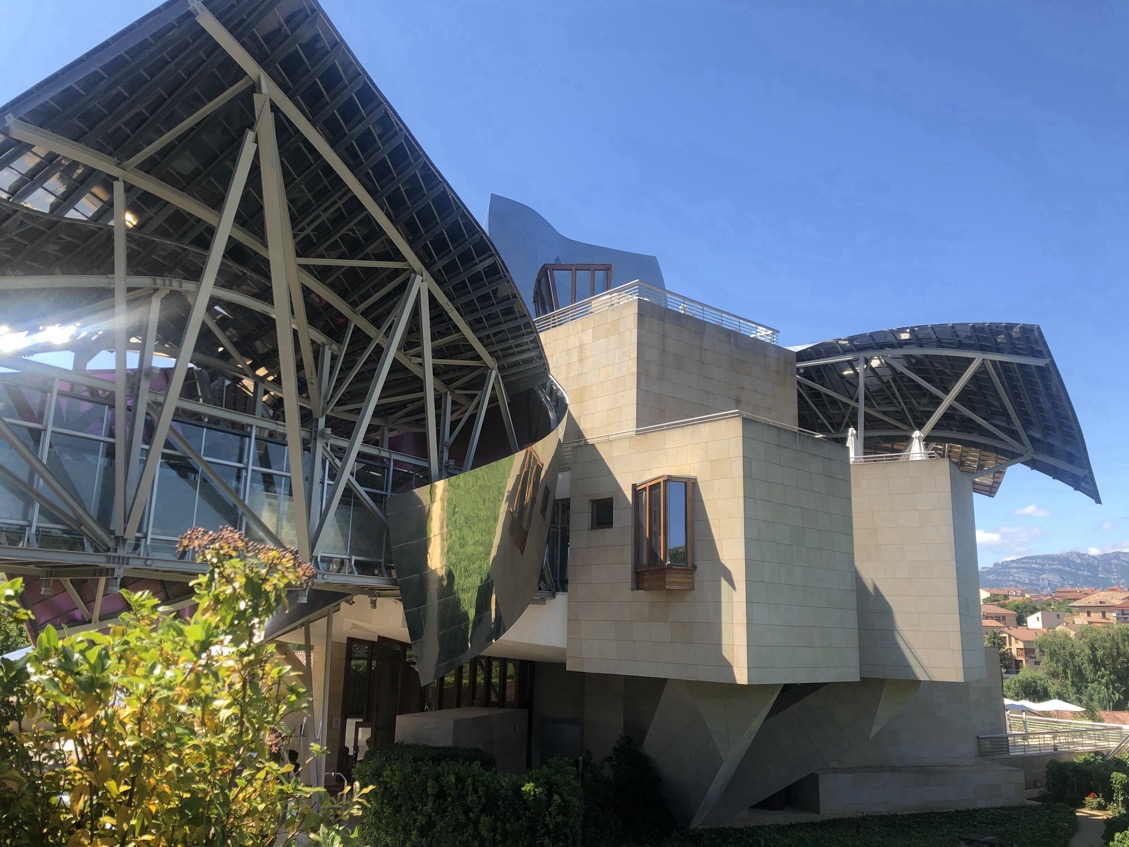
Room service
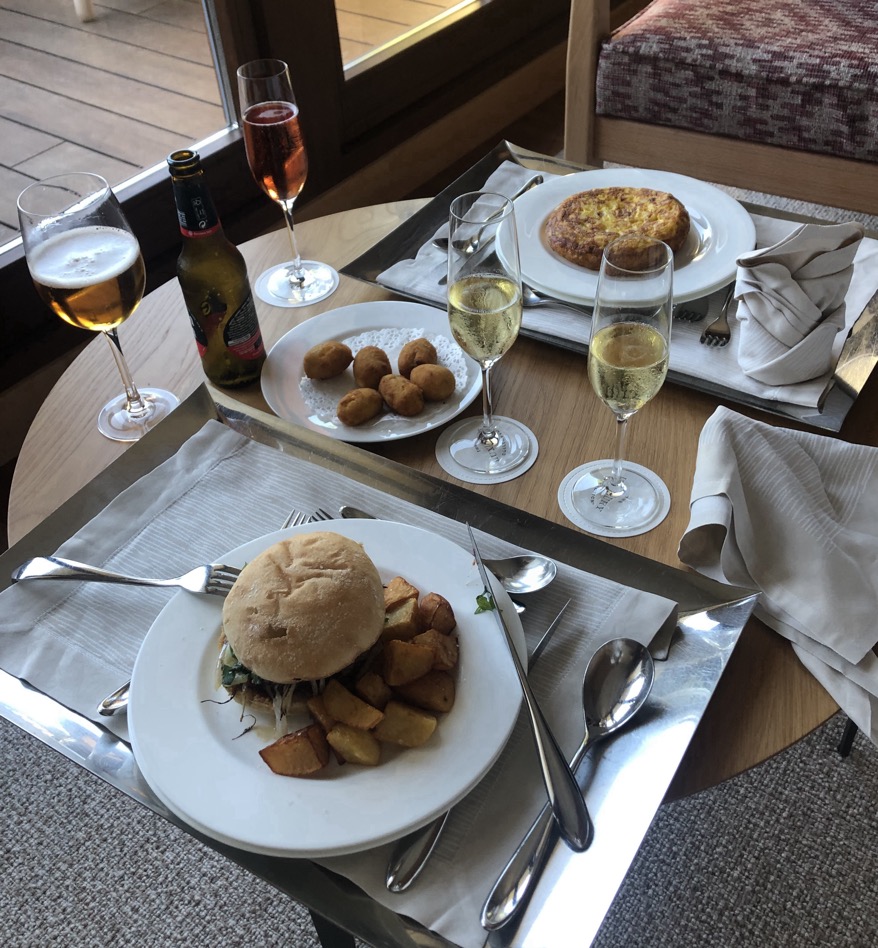
We decided to take room service for our evening meals, and mixed and matched with starters such as croquettes with Spanish ham and chicken, and Spanish omelette with onion. Main courses were battered hake with peppers and an aged beef burger, alegría riojana sauce (hot pepper), pickled, cured lard and cheese (which in my opinion was fantastic). Desserts were fruit salad and red berry ice-cream, chocolate cake with walnuts and heather ice-cream, and (my favourite) homemade crème caramel. Drinks included a local Spanish beer and a glass of Rosé Cava for my wife.
Breakfast

Due to COVID breakfast was served at the table, but included fresh orange juice, fruit salad, cold meats and cheeses, and a selection of pastries, breads, etc. with jams. So an excellent continental style breakfast, to which was added a chef special based upon eggs, which changed every day.
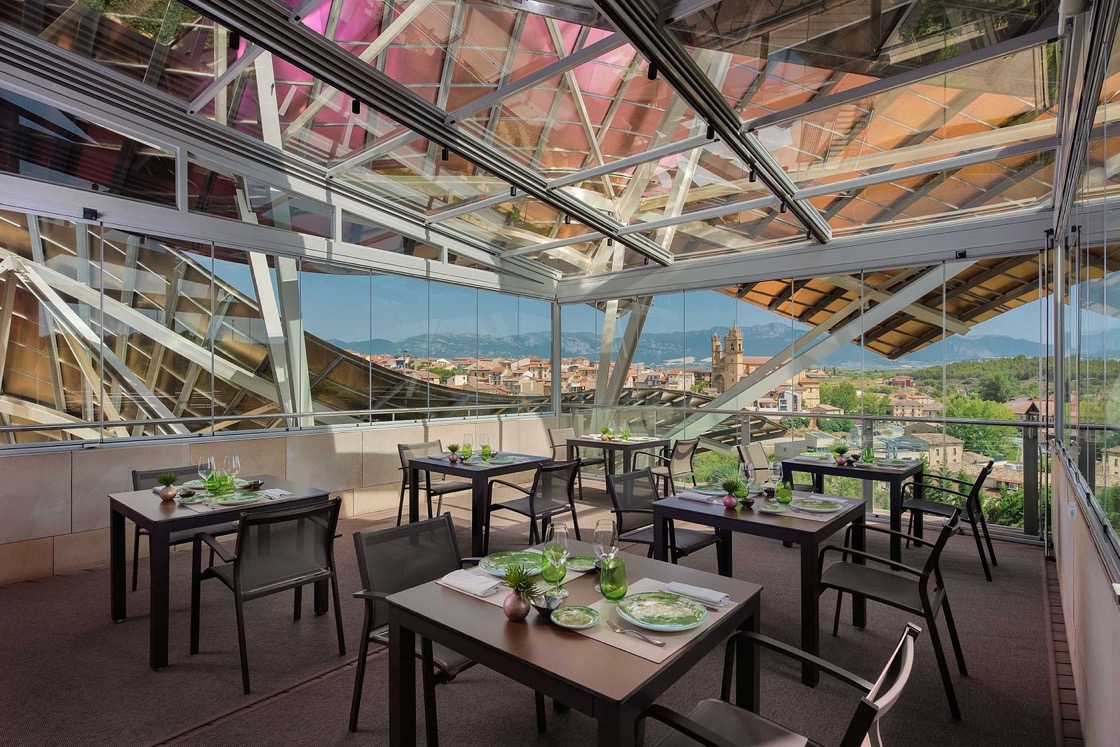
The breakfast was served on an enclosed terrace on the 2nd floor of the main building. Which started to give us an idea of the internal structure of the Gehry building.
The Spa

The spa consisted of a large pool, a hammam, a sauna, an external terrace, and a series of treatment and massage rooms. It was quite a substantial space, and very well equipped, however, as with many sauna's in Spanish hotels the temperature was too low. The hammam was a bit better, but still not quite set at a challenging temperature.
Our visit in December 2022
For our second visit we booked a so called Deluxe Spa Room, with vineyard views, but were upgraded at no additional cost to a Premium Spa Room with a view of the Elciego village (the same room that we had on our previous visit). The rooms with vineyard views may be a touch bigger, but they don't have the terrace, which is a real asset in the summer.
Here are our additional comments from this second visit.
This time our car navigation system took us directly to the real main entrance to the site (we had updated the in-car navigation map for Spain).
The porter took our bags and parked the car, but this time he kept the car key. The porter showed us our room, but he also rapidly pointed out the TV and central heating controls, but did not mention Internet access. The porter also mentioned that just before Christmas the hotel was quiet, but would be ⅔ full over the Christmas and New Year weekends. In fact one could see that the covered parking was almost empty.
This hotel was the 4th on our trip through France and Spain, and I must admit the Premium Spa Room compares very favourably with the first three hotel rooms (see my report on Loisium Wine & Spa Hôtel Champagne, Relais de Chambord, and Hôtel Chais Monnet & Spa, Cognac). It has the usual features, e.g. large flatscreen TV, minibar, complimentary water, a good sized in-room safe, tea and Nespresso coffee making facilities, etc. But having sampled three hotel rooms in France before arriving here I was acutely aware that the room in the Hotel Marqués de Riscal was both very comfortable and very welcoming after a day in the car. This time I was truly impressed with the size of the room, the large bed, the comfortable sitting area, the large windows opening on the good sized terrace (too cold to be used in December). And the view from the terrace over the main hotel building and the village in the background was still very compelling. Perhaps the most impressive feature is the very large bathroom, which includes a bath, large separate walk-in shower, a separate space for the WC and bidet, and double washbasins.
Post-COVID cushions and a bed throw had reappeared in the hotel room, and whilst I don't like bed throws the soft furnishings did add a bit more colour to the room and gave it a touch of extra luxury.
We again took room service, selecting from what appeared to be a more extensive menu (now again presented as a paper menu in the room). Starter options were croquetas/croquettes (€14), tortilla de patata/Spanish omelette (€18), paleta Ibérica/Iberian ham (€26), club sandwich (€18), and ensalada de tomate asido/roasted tomato salad (€13). Then there was fresh pasta (€16), salmon poke (€22), soap de pescado/fish soup (€19), and escalopes de merluza/fried hake (€18). The meat dishes were hamburguesa de vaca vieja/dry-aged beef burger (€20) or solomillo de ternera trinchado/chopped beef sirloin (€28). Postres (dessert) was pastel de requesón/cheesecake (€11), torrija de brioche en cocotte (€11), tarta de chocolate con nueces/chocolate cake with walnuts (€9), fruit salad with red fruit sorbet (€9), or a surtido de quesos/local cheeses (€10).
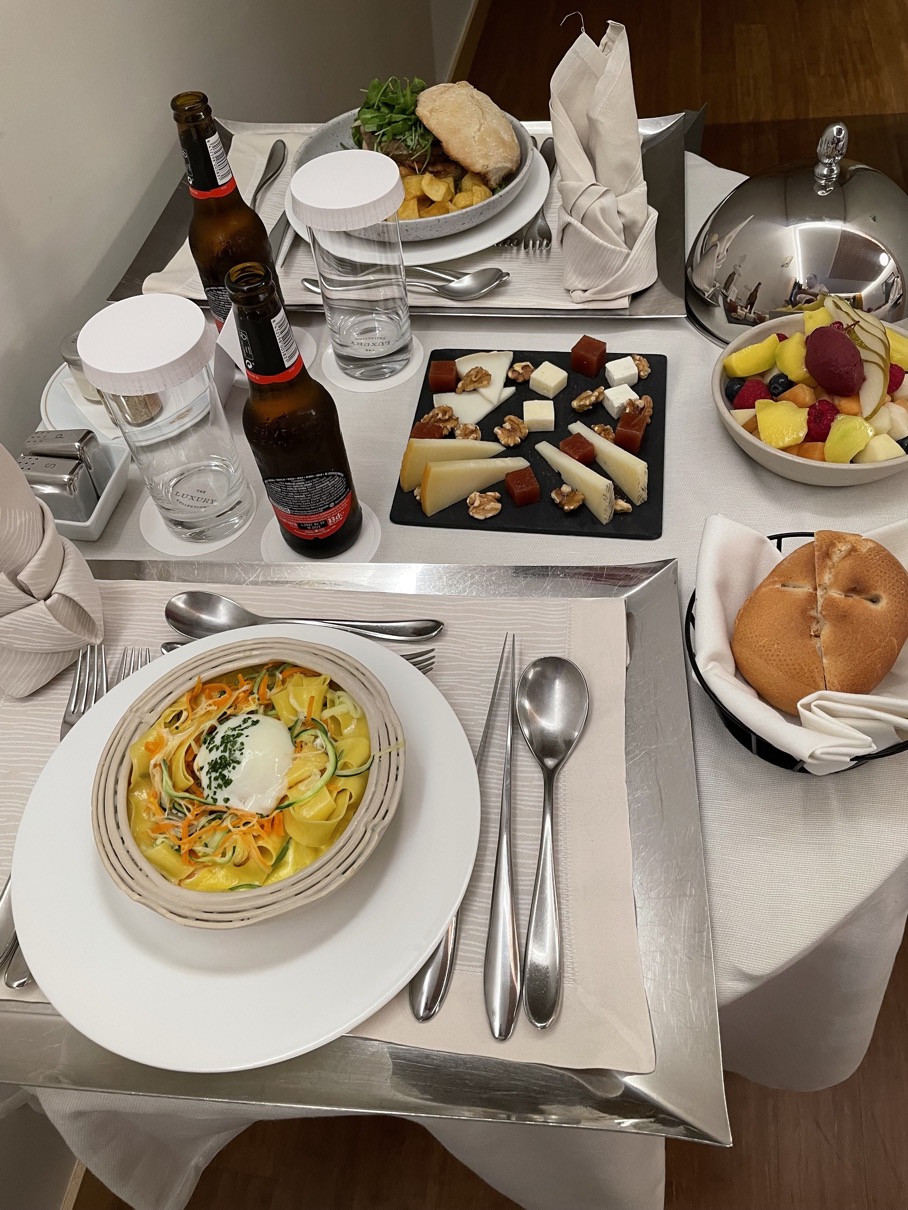
I stayed with the beef burger and the local cheese selection, whilst my wife took the fresh pasta and the fruit salad. Our preferred drink was Estrella beer, but we also drank the complementary ½ bottle of the local house wine.
I enjoyed the burger (its was as good as last time), but as last time the potatoes were nothing to write home about. I throughly enjoyed the Spanish cheese selection, and it compared vary favourably with the cheese selection I had taken in the previous hotels on this trip. The pasta was well prepared and tasted good, but I think it was a mistake to offer pappardelle. When the long ribbons are prepared with a robust ragù and a good dose of parmigiano, they stick to the fork, but with a light liquid sauce they were almost impossible to eat cleanly. Pappardelle is not a good pasta for a room service meal. However, my wife enjoyed the very complete fruit salad. The bread roll was disappointing.
As during our last visit there was free access to the Spa, but as with our last visit the sauna was only set at 70°C (far too low), and whilst the hammam was a bit better, it was still not quite hot enough.
Conclusion on our two stays in the hotel
On our first stay I concluded that the Hotel Marqués de Riscal was a good example of a 5-star hotel, if anything our second stay reinforced this conclusion. The room was excellent, the room service meals were competitively priced, and the room included breakfast, parking, complementary access to the spa, and a complementary visit to the winery.
On our first visit I thought that a few more interesting alternatives on the room service menu would be an improvement. And on our second visit I found a a more extensive room service menu with some new and more attractive options (even if I did select again the excellent hamburguesa de vaca vieja/dry-aged beef burger).
In our first visit I was not sure if the complementary visit to the winery was not a cut-down version of a tourist visit. I would have like to see more of the site and both the historical and modern-day wine making processes. Unfortunately we did not repeat the visit during our second stay in the hotel.
At the time of our first visited I tended to agree with some reviewers who noted that staff were professional and helpful, but not particular friendly. Some reviewers suggested that this might be rated to the fact that the hotel was really not part of the Marqués des Riscal, i.e. it was completely outsourced to The Luxury Collection of the Marriott International, the company that franchises and manages properties. I must admit that on our second visit all the hotel staff were both very professional and very friendly, possibly because they knew we were returning guests.
Also during our first visit I noted that the two ladies in the breakfast room were an exception, being both very friendly and enjoyable to chat to. On our second visit, they were no longer an exception, but they remained the most friendly and welcoming pair I have seen in many, many hotels.
After our first visit we asked ourselves, would we return again? We were positive, but we did not think we would make an excessive detour to do so. After our second trip, we have now concluded that we would make a specific detour to stay again in the Hotel Marqués des Riscal.
Marqués de Riscal - a Mecca of wine tourism
Let's step away from the Marqués de Riscal and its Gehry building for a moment. In 2020 the world production of wine was probably about 260 million hectolitres, which is slightly down on the bumper year 2018. But given the COVID-19 pandemic, the move to reduce harvest volumes in the EU, unfavourable weather in South America, bushfires in Australia and drought in South Africa, 2020 is considered to have been a good year. Spanish wine production in 2020 was actually up by 11% as compared to 2019, but was still 11% lower than in 2018. Since 2017 world-wide wine consumption has decreased from 245 million hectolitres to less than 235 million hectolitres in 2020, and noticeably in Spain wine consumption fell by nearly 7% in 2020 as compared to 2019.
It has been estimated that for 2020 the total surface under vines world-wide (wine, juices, table grapes and raisins) was about 7.3 million hectares, which is down from 7.8 million hectares 2002. For example, the vineyard surface cultivated in Spain dropped by 0.6% between 2019 and 2020.
The purists might not like it but the trend to bag-in-box and canned wines is expected to increase, and don't forget that marijuana-infused wine is just starting to become popular in the US. In some countries without a long tradition in wine, there is a move to dilute wine with soft drinks, or to go for lighter, sweeter style wines.
More importantly the move to organic and biodynamic wines has for the last few years registered a 20% annual growth, and even more in both Spain and Italy (even if it still only represents about 4.5% of the overall market). Another trend in emerging markets is to focus on brand names, and in particular luxury brands, which naturally has caught the eye of counterfeiters.
Increasingly it is not enough to simple produce a good wine and expect customers to gravitate to better quality products (even if a score of 90 or more can still create a Parker effect). New wine producing countries are also improving their wines and they can compete on price, meaning that traditional producers are losing market share. One way to counteract these losses is to open up new markets, either by looking to new consumer markets, or by focusing on customers with high purchase power. Over the past years producers have turned to new technologies to reduce the cost of wine production, and more recently they have started to look at bioclimatic and ecological issues. Some producers, including Marqués de Riscal, have looked to aesthetic factors, and in particular the role of architecture as a way to underline both technological innovation and traditional values of wine quality.
Architecture is not just about appearance, it can be used to re-visit the classical processes of grape reception and transportation through the plant, fermentation, and wine ageing and storage. There is a distinct move to multi-floor buildings using gravity to transport the harvested grapes, and reduce over-pumping thus allowing the must or wine to decant from one floor to a lower floor. Transferring wine by gravity and not by pumping means that the wine does not suffer friction or warming, or in some cases being subject to excessive pressure. This does require an additional investment, but the footprint of the plant is reduced, freeing up more land for other uses. Equally there is an increasing focus in Europe on wine ageing in lower basements or in underground dugouts, where the humidity and temperature are controlled naturally (so-called hygrothermic conditioning) thus reducing energy consumption. But this requires more land and excavating underground ageing areas can be costly.
All this might appear secondary to making good wine, but one study showed that involving a prestigious architect or artist can increase export volumes by up to 20%.
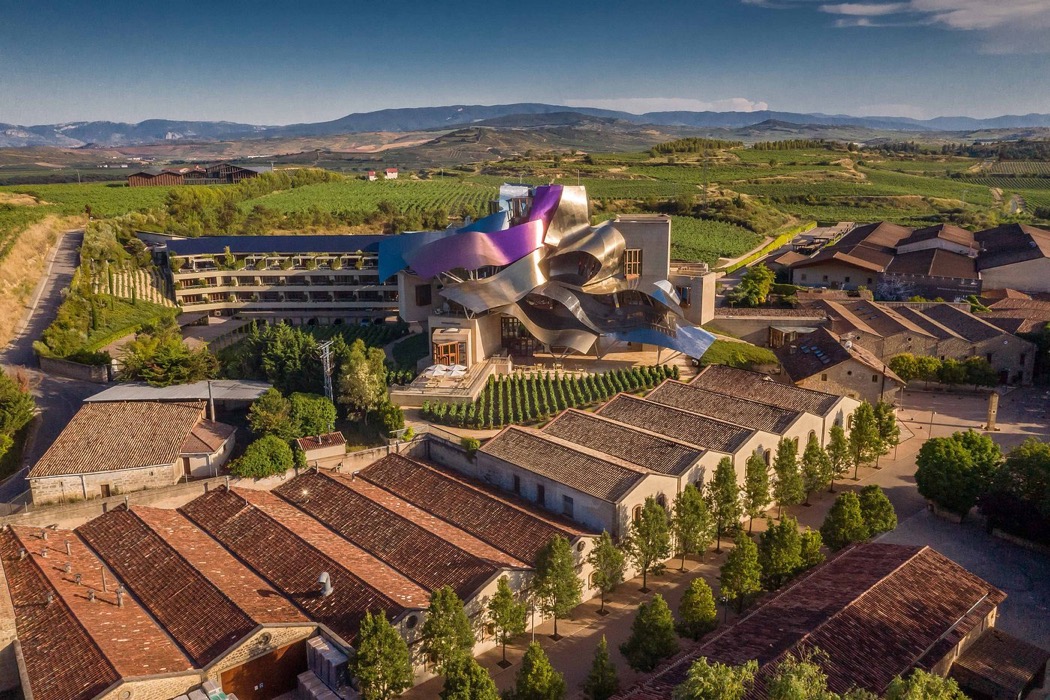
We might take the idea of a "City of Wine" for granted now, but in 2006 it was quite revolutionary in the way it integrated a post-modern hotel, a wine therapy spa and a Michelin-star restaurant, all set within a historic 23-acre wine estate. And not forgetting the ubiquitous conference centre, the second restaurant, the coffee bar, and the on-site shops. The objective was simple, attract the attention of tourists and increase wine sales. A € 70 million investment, but one that saw a near 70% increase in visitors, and now a waiting list for the hotel rooms.
Initially wine tourism (enotourism) was just about tasting and purchasing wine directly from the producer, but over the last 20-30 years the whole area of ecotourism has evolved dramatically. Most wineries still don't offer a formal tourism experience, but some traditional wineries have created a specific tourist offering with a visit and tasting. And today there are wineries that have been specifically designed or re-designed to offer a series of tourist offerings, e.g. visit, tastings, shops, museum, restaurant, etc. Some have gone one step further, offering concerts, party hosting, company outings, or even wedding hosting services. The "City of Wine" of Marqués de Riscal goes beyond that by trying to create a "wow experience".
Already in 2000 it was estimated that in France about 20% of all wines sold are direct sales to consumers, and in 2017 it was estimated that a visitor to a wine region in the US will spend nearly $750 on accommodation, food, and wine. For example, Napa Valley receives about 4 million tourists per year, and over 1 million of them stay overnight. The economic impact of wine tourism in California was estimated at more than $ 7 billion in 2016. Wine tourism is seen as vital for the small wineries that don't produce enough to have a US nationwide distribution. In fact, 98% of US wineries produce less that 140,000 bottles a year, and sell up to 70% of their production through their tasting rooms (for comparison Marqués de Riscal produced 6 million bottles per year). In Spain, in pre-COVID times, visitors exploiting the "Wine Routes of Spain" varied between 100,000 in January and over 300,000 per month for the period April to October. That translates to over 3 million visitors per year to Spanish wineries for 2017, 2018 and 2019.

Research has shown that visitors to the Marqués de Riscal site actually enjoy the incongruence between the post-modern architecture and the surrounding historic buildings, i.e. creating a surprise or even "wow" effect. Above all, the hotel has transformed the brand image of Marqués de Riscal from staid to something far more modern and memorable.
A bit of history
It interesting to note that in the past Marqués de Riscal was also known for its willingness to adopt new ideas for both production and marketing. Initially they adopted the Bordeaux method in winemaking, which later would influence other wineries in the region, and later still would set the standard throughout the Rioja wine sector. However, the reality was that many producers either sold a poor quality local wine or simply exported their production to the Basque market, and even in the latter part of the 19th century Bordeaux-style wines represented only 4% of the production in the Rioja. In terms of marketing, Marqués de Riscal were the first to register the brand "Vinos de los Herederos del Marqués de Riscal, S.A.", and already from 1850 they were exploiting the new railway network to distribute fine red wines into markets usually reserved for average quality local wines.
It would appear that a certain Manuel Quintano (1756-1818) had already tried to import the Bordeaux technique in about 1785, and the results were convincing. The wine was of a good quality, sold well despite being expensive, and was even exported to Mexico and Cuba. However he came up against hostility from his neighbours, who managed to stop production by means of an ordinance which imposed a single fixed price on all the wines from the village. So given that production costs of his wines were higher and the low prices imposed prevent them from being sold profitable, the experiment failed.
Both the Marqués de Riscal and de Murrieta noticed that Bordeaux wine sold well in London, and at high prices. They adopted the techniques and were also able to make the considerable investment needed. You have to remember that the Bordeaux technique was a real revolution both in terms of organisation and in the disruption of the economic model. Indeed, to make fine wine, capable of travelling, being kept and even improving with age, it must be aged. This is a process that takes place over several years, and producers were no longer able to sell it quickly. It was therefore necessary to store the harvests of several years, to leave the wine in barrels, then in bottles, before finally putting it on the market. This implied that at the start of the process the producer has no wine to sell. It was therefore necessary to tie up capital, without immediately generating revenue. In addition, they had to buy barrels and bottles, and then to store them they needed to construct buildings with thick walls, or dig underground cellars, in order to obtain effective thermal insulation and avoid variations in temperature. This strategic choice was therefore very expensive, and it involved an ability to wait ten or fifteen years for a return on the investment, something only accessible to wealthy investors, aristocrats or industrialists.
We have to remember in the last third of the 19th century, viticulture had emerged as the most cutting-edge sector of agrarian modernisation, in particular for the little-used soils of La Mancha, La Rioja, Catalonia and Valencia. Both the families of de Riscal and de Murrieta visited the Universal Exhibitions of London, Paris and Vienna to learn about the most advanced techniques for making quality wines. With what they leaned in Bordeaux they were both able to produce a quality wine that slowly emerged as the benchmark for good Rioja wine. Here is an excellent article concerning the creation of the Rioja wine Marqués de Murrieta.
It was Guillermo Hurtado de Amézaga, Marqués de Riscal, and his son Camilo Hurtado de Amézaga (1827-1888) who decided to focus on exporting their wines, believing that the higher commercial margins were essential to maintaining the business. In addition, they felt that foreign markets offered better growth opportunities. In particular Camilo Hurtado de Amézaga knew that they had the land, production method, storage facilities, and financial capacity, so the key was the marketing of the product. In fact he wrote at the time "The price of 30 reales per jar that they give today for wine in Bilbao does not remunerate the sacrifices made nor does it allow them to continue, in order to bring all the services on this estate to the due perfection". Therefore, Camilo Hurtado considered it a priority to be in direct contact with the consumer, so it was essential to go every year with samples to England and Germany in search of orders. According to the data, the business really was in the export of fine wines, since the clients in Bilbao were only willing to pay up to 30 reales for the pitcher, while in London inferior Catalan wine was sold, put in bottles, at a rate of £ 20 (or 1,920 reales) for the 225-litre Bordeaux barrel (still used today).
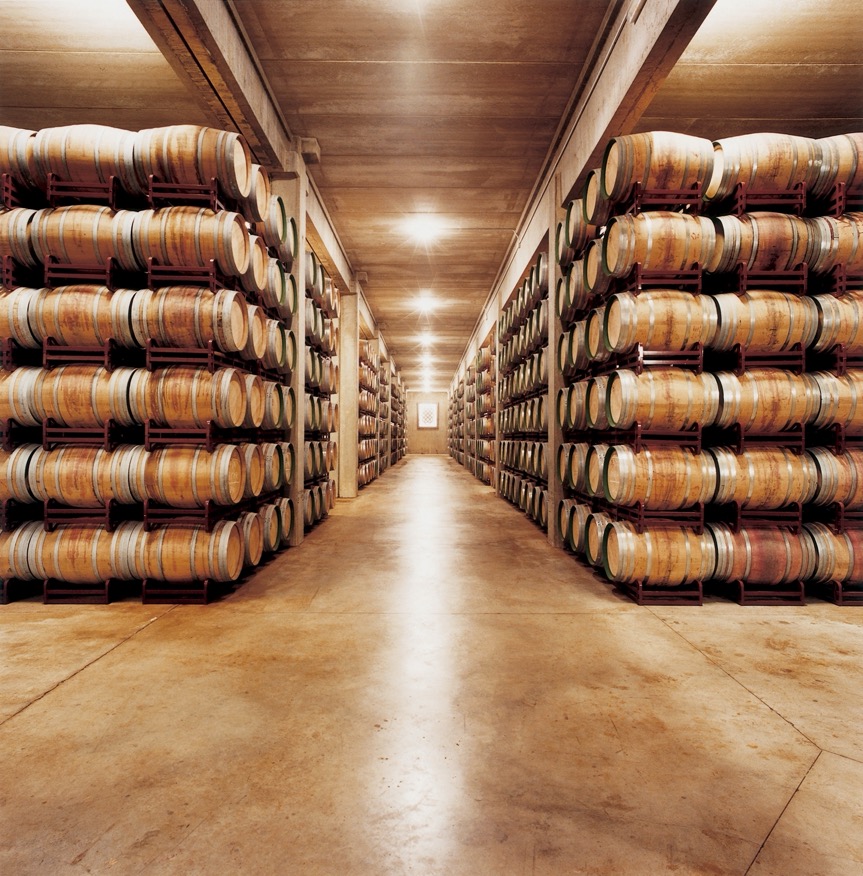
The cost of the bottles and corks was 384 reales, the cost of the shipping and customs was another 288 reales, leaving 1,248 reales net per barrel, which was the equivalent of about 87 reales per pitcher. In addition, he had already concluded that in 1862, Spain was not yet ready for the sale of fine wines, which were of a much higher quality but also much more expensive. In addition, at the time in Spain there was virtually no market for vintage wines, what local clients wanted were wines with a high degree of alcohol, strong and dark. The Marqués de Riscal, had a very different conception of the product, wanting to produce a clear, clean and smooth wine, and in 1863 he even complained that local consumers did not realise that aged wines were healthier and tasted better. It helped that Guillermo Hurtado de Amézaga had lived in Bordeaux since the mid-1830s, and knew very well how the wine market worked there. His son Camilo, was a commercial attaché in London, so well informed about the importation of wines into England. Therefore it's not surprising that they would focus on London, and in addition throughout the 19th century the United Kingdom would become the world's largest importer of wines.
One good question is about competition with French wines in the London market. What had happened was that the French "châteaux" had resorted to local "negotiants" who would work with "traders", who were for the most part English, Irish and Dutch. The "negotiants" were a significant barrier to entry for winemakers, because firstly, they preferred to distribute already established producers, and in addition, they had restricted space to store wine, were averse to risk, and were not willing to fund the high fixed costs that were associated with distributing a new wine. However, the French did export aged red wines, whilst the Spanish had no system for ageing and exporting their wines. At the time there was no notion of controlled designation of origin, and French producers would buy wines from the Rioja, which was not struck by phylloxera until several decades later. Once the French had replanted vines and reconstituted their vineyards (post-phylloxera) they simply stopped buying Spain grapes, making the local Spanish producers pay for their lack of investment and their focus on low quality wines. In addition, in 1882 the French had already stopped the application of reduced custom duties on imports of Spanish wine.
We mentioned that Marqués de Riscal had exploited the new railway network to ship its wine. This was particularly important since traditionally Rioja was transported on the backs of mules in large animal skins that had been coated inside with pitch, which left an unpleasant taste to the wine. On top of that, if left in the heat of the summer the wine quickly turned to vinegar. The train first ran from Bilbao to the French boarder, ran at up to 40 km/h and transported 100's of barrels. When coupled with new bridges, etc. it meant that Rioja wine could be more easily transported to Bordeaux than to most parts of Spain. Later the rail network would make it much easier to transport wine to the ports on the Spanish coast (ready for export to the Americas). Put this together with the introduction of the telegraph, and we have a true revolution in the making.
This highlights the foresight of the founders of Marqués de Riscal in looking for a wine that could travel, keep, and improve with age. There were several wines that travelled well, but the best example was Bordeaux wines, almost certainly because they were wines aged in oak barrels. Initially just wooden barrels were used because they contained a lot or wine, but were still easy to handle. Later oak was used when they found that wine stored in those barrels actually improved with age, and the Bordeaux 225-litre oak barrel became the standard. The use of these barrels was part of the Bordeaux technique copied by Marqués de Riscal.
So with Camilo Hurtado de Amézaga, the Marqués de Riscal winery only focused on quality wines and the vertical integration of all processes, from its own harvest to packaging. The grapes only came from their vineyards or from vineyards in nearby areas of Rioja Alavesa itself. The two key elements for them were quality rather than quantity, and international distribution.
From the latter part of the 19th century until 1930 there was a more or less continuous economic crisis. In fact in 1928 the Bordeaux authorities defined their area as “une región actuallement aux confins de la misère”. The problem was twofold, first the French market was closed and other markets had introduced protectionist tariffs. Secondly, the presence of both powdery mildew and downy mildew forced winegrowers to carry out more careful and more frequent digging, plowing, and pruning as well as introducing improved grafting practices. Plus the increased use of fertilisers, all led to a rise in production costs.
The approach of Marqués de Riscal was valuable because they were not dependent upon their local market and could diversify the commercial risks. Already in 1862 the approach of Marqués de Riscal was twofold. Firstly, they tried to help the region produce more fine red wines, and this started with trying to help promote and sell those wines. Secondly, they were more or less forced to establish very extensive commercial networks to be able to place their fine red wines outside the traditional commercial channels for Rioja wine. Camilo Hurtado de Amézaga knew that the Bordeaux method in winemaking would be copied with relative ease, and that it would no longer be a competitive advantage. He felt that in the future the important things for Marqués de Riscal would be brand image and its commercial network. The creation of the brand image of the Marqués de Riscal wines began at the Bordeaux exhibition in 1866, where his wines were unveiled and his efforts were rewarded with a first-class silver medal. Exhibitions in Dublin in 1866, Vienna in 1873, Paris in 1878 and 1889 would help to consolidate the image of Marqués de Riscal as a brand of quality wines. Most importantly, in 1895 at the Exhibition of Bordeaux, Marqués de Riscal wines with more than four years of ageing were awarded the "Diploma of honor" (its still part of their front label).
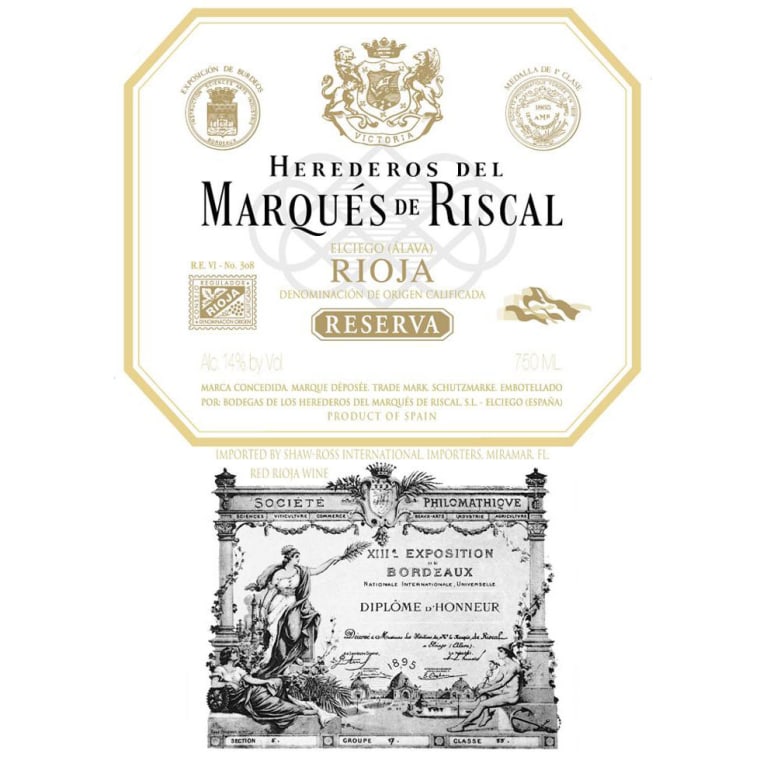
Information is scarce, but by 1928 "Herederos del Marqués de Riscal" had in place a worldwide network of representatives and distributors. They had 123 distributors in Spain, and another 66 distributors around the world. In many cases, for example in England, France and Italy, they had single exclusive distributors. But in South America they had nearly three times as many distributors as in Europe, highlighting the value of a common language, and the usefulness of the ports of Santander, Bilbao and Pasaia. This sales network was able to grow the companies client list from 278 in 1907, to 686 in 1915, and to 1,859 in 1941. More importantly, they shipped around 89,000 litres, whereas in 1941 they shipped more than 310,000 litres. In 1907 they serviced 133 orders with an average of 670 litres per order, whereas in 1941 they serviced 1,345 orders, but with an average order of 232 litres. We can see an explicit intent to reduce commercial risk by expanding the client base. The arrangement with their distributors was simple. They had to be financial stable and have a wine storehouse. They had to take at least 5,000 bottles, and pay all the expenses from the Cenicero railway station in the Rioja region. They had to sell according to a price list and could not discount. They would get a discount of 10%, or 12% if they immediately paid in cash. During that period Mexico and Cuba were the main markets (taking between 65% and 80% of all shipments).
Paradoxically, Marqués de Riscal, sold well during the Spanish civil war. In 1936 they sold domestically about 46,000 litres and in 1941 they sold nearly 240,000 litres. No doubt this was because the company retained a certain friendship with the Nationalist fraction. Still today, the company is known to have a maintained good relations with Spanish public institutions, irrespective of political tendencies.
The Gehry building

If you have read through the above sections you will know that Marqués de Riscal has innovated in the past, and thus it's not surprising that they still looked to innovate today. The logic is simple, and it starts with the fact that the Guggenheim of Bilbao, inaugurated in 1997, had served as a catalyst to invigorate the decrepit port area of the city along the River Nervión. A single building had put the largest Basque city on Europe's cultural and tourist map, i.e. the "Guggenheim Effect".
I've not seen a detailed description of how the Marqués de Riscal winery actually decided to create the "City of Wine" concept, and how they picked Gehry to build a hotel and spa complex. But we can certainly identify some elements that must have played a role. The example of the Bilbao Guggenheim is less than 120 kilometres away. We know that the winery needed to build a new storage area. Occasionally you also see mention of an initial idea to build new offices, etc. for the winery, but we don't know how that grain of an idea developed into the decision to build a hotel and spa complex. However, the concept of a "temple to wine" had already been developed in 1991 by the architect Domingo Triay for the Artesa winery in Napa Valley, and they would have known that Bodegas Ysios had commissioned a new winery from the architect Santiago Calatrava.
Gehry is not known for the subtlety of his buildings, and there are as many people who don't like Bilbao Guggenheim as do. So deciding to go with him as the architect for the Hotel Marqués de Riscal had its risks, but must be applauded. It was a decision not to simply build a conventional space based upon a simple functional specification. They must have been ready to accept Gehry's artistic independence and above all they must clearly have wanted a piece of sculptural Architecture with a big "A". Not just another building, but something that would create a permanent cultural buzz (and hopefully make money at the same time).
The idea to dramatically renovate the Marques de Riscal winery, which had changed little since 1860, took form in 2000 and the final building was inaugurated in 2006. Gehry had been contacted and had agreed to create the striking "City of Wine" complex that was to include a hotel and spa.
According to Gehry, the € 70 million wine 'temple' would reflect the essence of the wine, and I guess the winery hoped that the new building would have the same effect for them, and for the small town of Elciego, as it did for Bilbao.
Some months after accepting the commission, Gehry spent a weekend in the winery and tasted, among other wines, one from the year of his birth, 1929. It is claimed that it was at this moment that he completely imbibed himself in the spirit of this century-old winery.
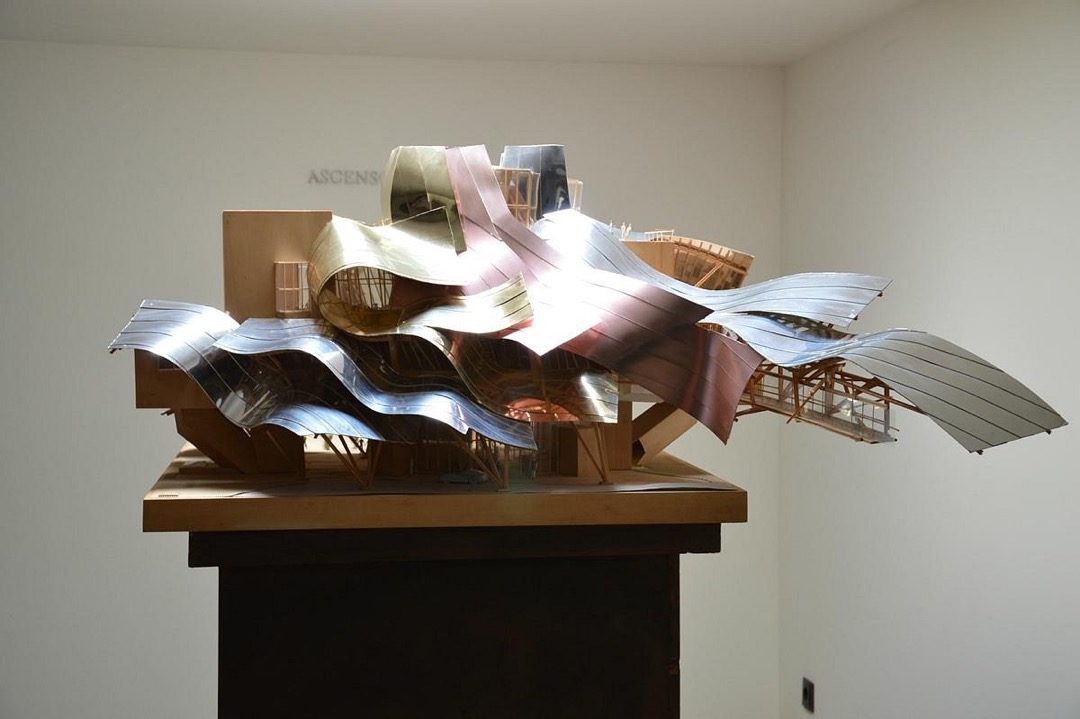
The initial design process in Gehry's studio is manual and begins with sketches and concept mockups, adopting the trial and error method of work. Different models are tested out, until the final model of the building is created, the one approved by the client.
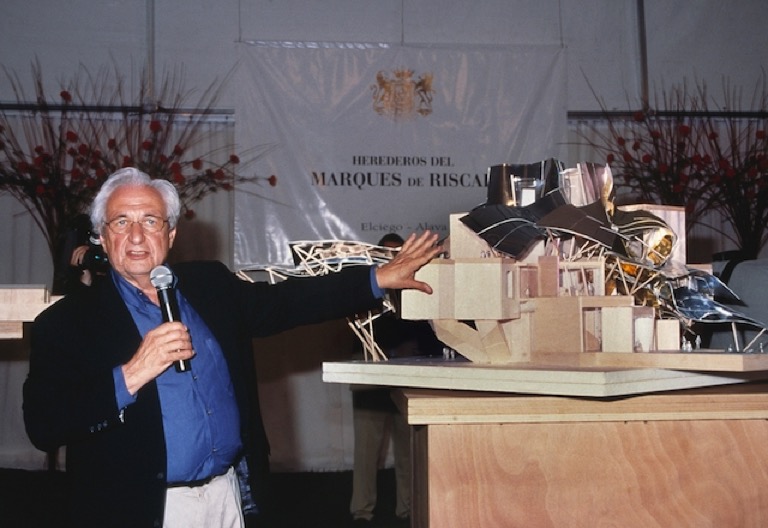
The first model was presented by Gehry himself on June 1st 2000, and was for a 2,765 square metre building with a 44-room hotel, a 120-seat restaurant, plus meeting halls and a shop. Already the serpentine forms, so characteristic of Gehry's work, were envisaged, with 1,600 square meters of stainless steel sheets and another 1,800 square meters of silver, gold, and burgundy coloured ribbons of titanium.
I'm not sure how this initial model evolved into the hotel we see today. What we have today, spread across an area of 2,000 square metres, is a hotel divided into two zones connected by a raised covered walkway. The main building comprises the reception, restaurants, meeting and fourteen guest bedrooms. The remaining forty-three bedrooms have views of the vineyards on one side and the mountains of the Sierra de Cantabria on the other side, and are located in the annexe along with the spa.
The complex nature of the surfaces of the building made traditional methods of computer modelling, analysis and design unsuitable for a detailed project definition. Gehry had already discovered the value of the CATIA (computer-aided three-dimensional interactive application), which is used in the aeronautical industry as a way to solve complex surfaces. Once the final model was accepted by the client, the outer surfaces were digitised, creating coordinates that, in turn, were transferred to CATIA. From this, the final form of the building could be exported to structural analyse programs, and then modelled and drawn for fabrication.
One of the challenges in the structural analyse was that the techniques are usually employed to test the stability of a regular structure supporting a regular shaped building. However, we will see that this structure is irregular and supported in an irregular way.
With such a complex and irregular structure, especially of the canopies, different checks and practical tests were needed. For example, the canopies were tested in a wind tunnel, and later optimised using a simulation program. Although the canopies do not place a significant load on the support structure, they could nevertheless act as a kind of sail, concentrating the wind and transferring a significant load on anchor points. In fact the canopies are just steel profiles anchored either to one of the floors of the building or directly to the ground. It turned out that most of the connections support only axial and shear forces, avoiding practically all moments of force, i.e. forces acting along the length of a canopy strut or across the canopy surface, and not placing a torque or rotational force on any particular anchor point.
Once the design of the building was modelled, it could be divided in two different structures, firstly a concrete support structure, and secondly the canopies.
If you just look at the building in front of you, your first guess is that it has a ground floor and two additional floors above. But in reality it has five floors, and an addition mezzanine in the extra-high fourth floor. As we can see, below the "ground" floor (or 1st floor to some people) is an underground area or storage cavity for 3 million bottles. In some plans this floor appears as a kind of double floor, and different reports mention the storage of casks or bottles. Then there is a reception area at ground level, and above that a floor with 14 bedrooms. Then there is the floor for the restaurants, including a mezzanine floor, and finally there a floor with a large library and terrace area.
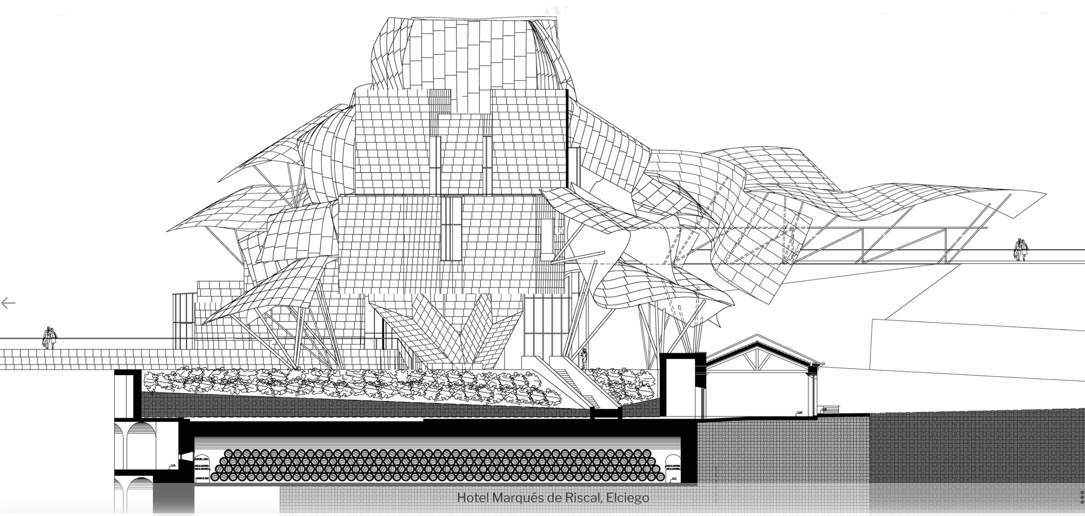
So in fact the foundations are 8 metres below ground, and the major load-bearing floor is a massive 1.5 metre thick concrete slab sitting above the reception area (i.e. the floor of the hotel rooms). The entire building structure consists of three 16.5 metre "super columns" starting on the rock below the foundations of the storage area, and supporting the massive concrete slab above the reception area. In addition to these three concrete lift cores there is a forest of smaller steel section columns hidden in the internal wall partitions. They spring out of the massive concrete slab and support the upper floor slabs.
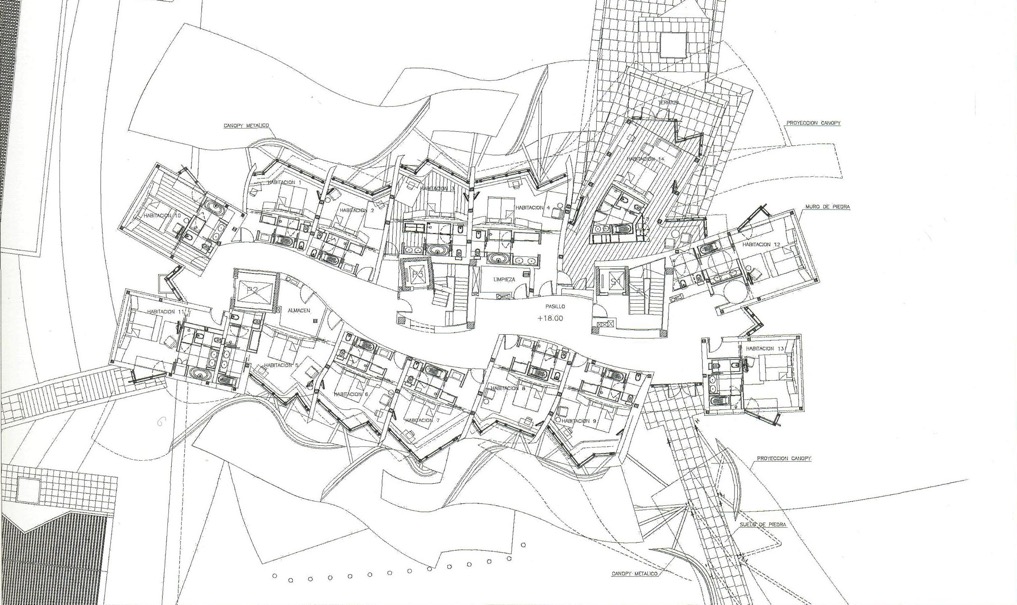
Let's have a look at what this all means in practice. The above plan is for the massive 1.5 metre thick concrete slab which is the floor for 14 hotel rooms. You can just about identify the three concrete lift cores, S1 is a service lift, P2 the interior lift, and P3 the public lift which is accessed from outside the building and used by those people going directly to the restaurants. You can see the incredible irregularity of the floor plan, which is made even more irregular by the fact that the exterior walls slope both inwards and outwards and support the smaller floor plan above. The window frames are made of galvanised steel with aluminium frames, all lined with wood. There is about 1,000 square metres of glass, however no two windows are the same size and shape and range from triangular to trapezoidal.

In fact, if you strip away the canopies, the core of the building is pyramidal in that each of the higher floors is smaller than the floor below. Having stripped away the canopies from the three floors and the mezzanine floor, the building actually consists of several cuboids pushed into one another. The three floors and a mezzanine floor cover about 2,000 square metres.
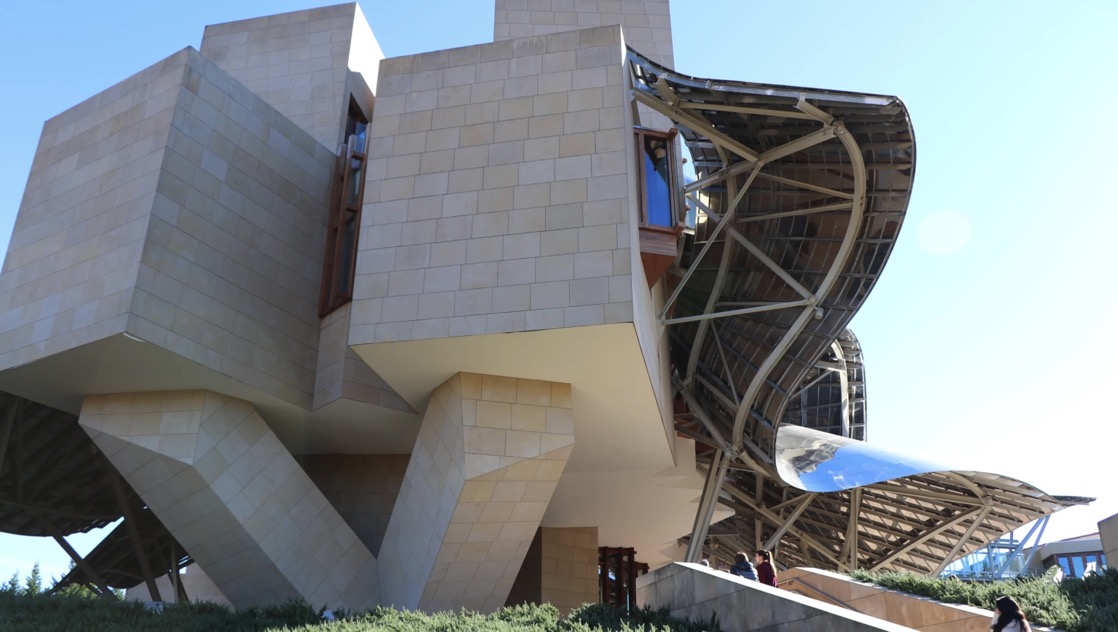
The massive 1.5 metre thick concrete slab sitting above the reception area is supported by the three concrete lift cores, and the cantilevers of the slab are supported by four prism shaped legs (you can see two of them above). The upper floor slabs are supported by metal beams concealed behind the walls. The stone façades are the same type of sandstone traditional used in the region for building wine cellars. Each stone panel is held by four-point anchors, and they provide both thermal insulation and waterproofing for the building.
The architect has offered a certain symbolism in the way the building models itself on a vine, with the three concrete lift cores and four prisms as the stems. The roots are the three concrete lift cores going down to the foundations of the new wine cellar 8 metres underground. In addition the upper floors are supported by irregular steel columns hidden in the internal partitions, a bit like smaller twisted branches of a vine.
Technically, the three concrete lift cores are aligned along the central axis of the massive 1.5 metre thick concrete slab. This slab, with the four addition "prism" columns supporting the cantilevers, supports the rest of the building above. However, the irregular form of this slab means that there is a permanent dead load moment on the three concrete lift cores. Supporting the rest of the building also means that the slab is highly loaded, and in addition the three concrete lift cores are designed to be very stiff and there are no movement joints. During the construction great attention had to be paid to prevent cracking caused by shrinkage and temperature changes during the pouring of the concrete (it was poured in one continuous process avoiding any joints, etc.). Given that the upper floors are supported by irregular and non-continuous columns, the different floor slabs are also designed to resist high point loads.
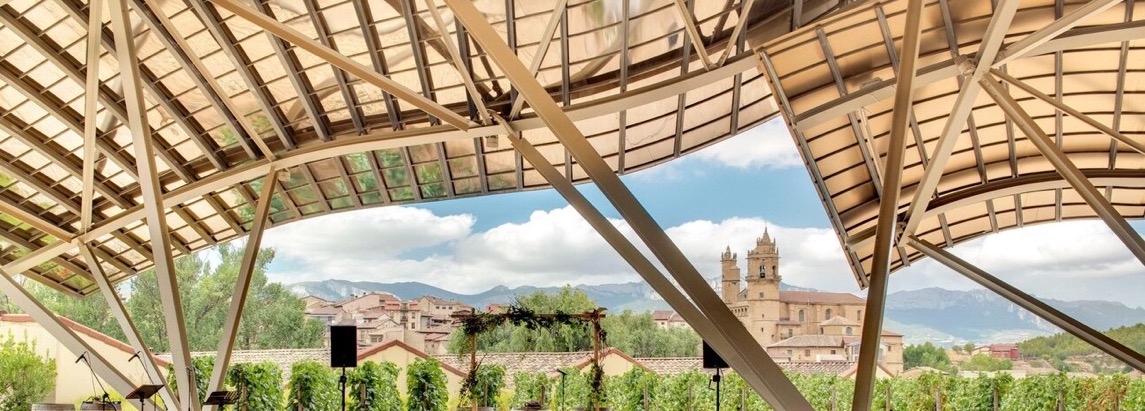
Turning to the canopies, they are independent self-supporting structures, each with at least three points of support. The upper canopies are attached directly to one or other floor slab, whilst the larger lower canopies are also supported by columns sat on the foundations of the underground cellar.
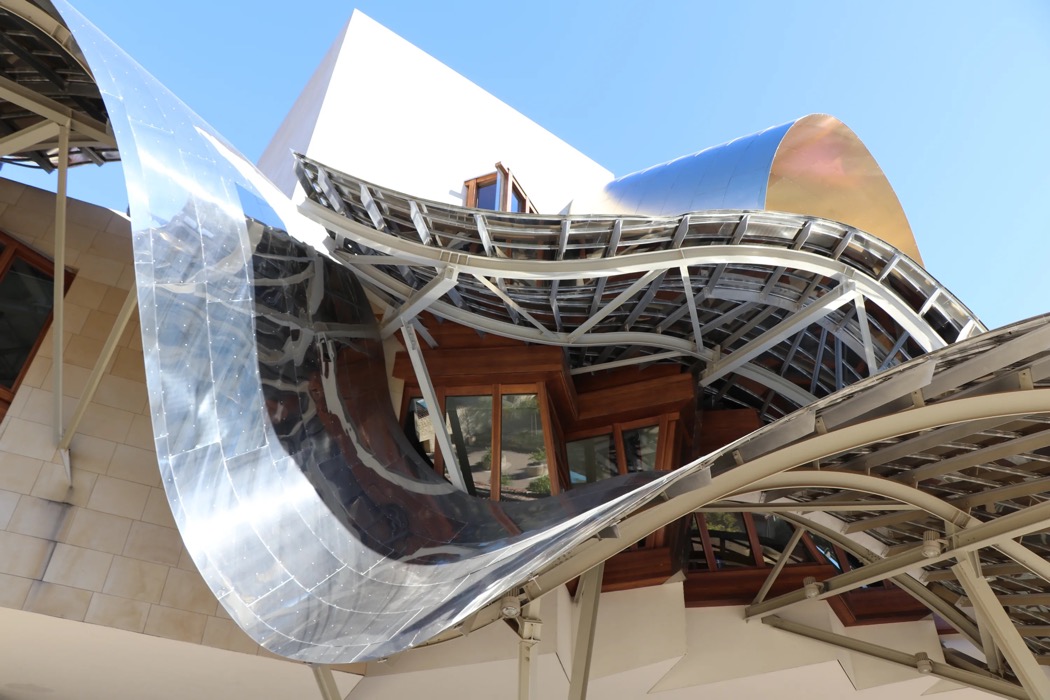
A canopy consists of two basic components, the frame or support structure, and then the actually covering. As much as anything, the design of the secondary structure supporting the canopies was a geometrical problem. Firstly, the whole structure is visible and therefore aesthetic considerations were as important as structural requirements. But the canopies are not just a strong visual signal, since they were also expected to frame all views from the hotel's windows, and to shelter the rooms from sunlight.
The first technical problem encountered in the design of the canopies was that of estimating the loads. The forms are so irregular that the wind codes could not be directly applied to the structure, so it help to be able to do some wind tunnel tests. Potential wind loads were added to the dead loads, including access-maintenance loads, snow loads and accumulated snow loads, each multiplied by a particular safety factor.
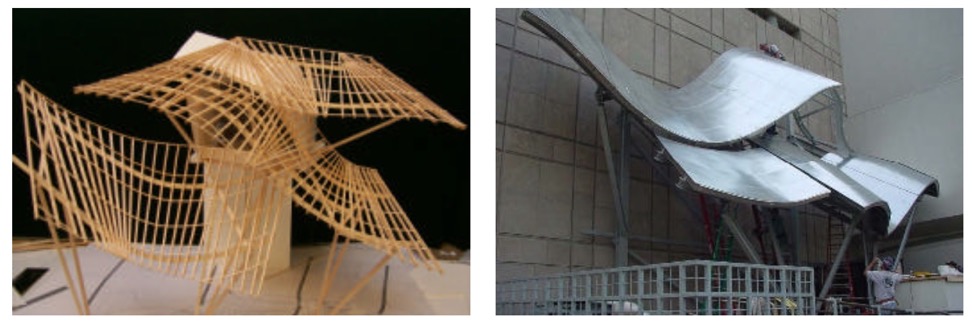
The design of the canopies was an iterative process. An initial design was carried out in order to estimate possible section sizes. In order to progress to the next stage of design a wire frame model of the canopies was required. This enabled the frame to be modelled in three dimensions, and thus the modelling of the surfaces also in three dimensions. Even life-size mock-up's were created to test both structural performance and the visual aesthetics.
The frames consist of two main beams (so-called I sections), highly deformed along their length, supporting T sections, 90% of which were straight. These T sections are supported at a variety of angles along the main beams thus producing a face curved in two directions without the need for bending beams in two directions. Over this surface were arranged 30 mm diameter galvanised curved tubes, 50 cm apart, which define the definitive curved surface. On these curved tubes are placed some support plates on which are riveted the canopy cover sheets, so avoiding holes directly in the tube.
The curved faces of the canopies are made up of a galvanised sheet skin placed between the T-profiles and the curved tubes. The inside of the cover sheets is lined with 6 cm of reinforced rock wool felt with aluminium, and on the outside it is waterproofed with a sheet of polyethylene and self-adhesive and self-healing rubberised asphalt. Finally titanium or stainless steel plates are riveted on to the tubes.
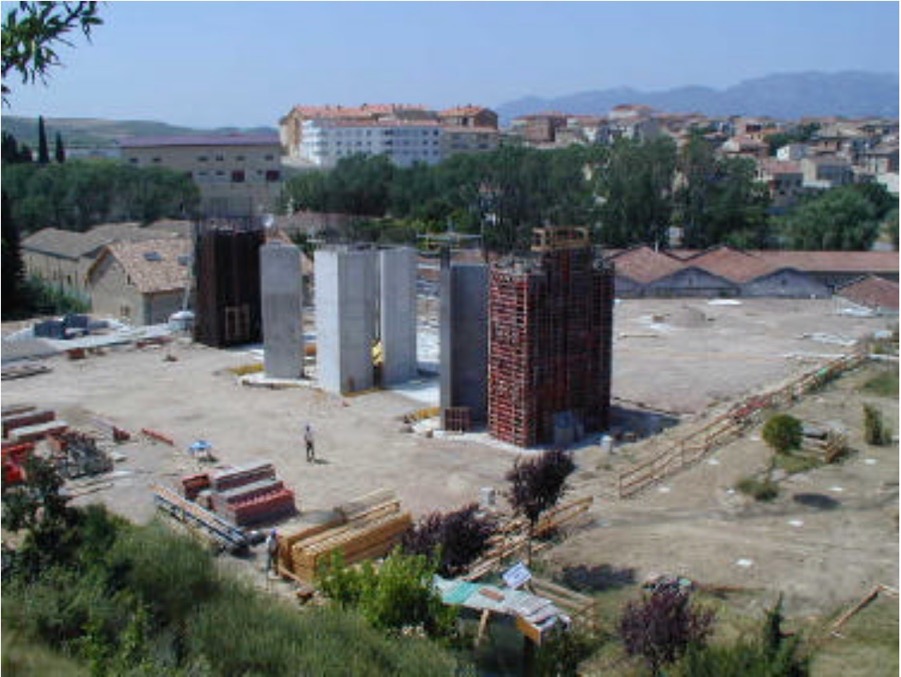
Construction got under way in 2003, and the building was inauguration on October 10, 2006. Above we can see the three 16.5 metre tall concrete lift cores (which include stair wells). You have to imagine that an 8 metre high underground storage cellar would then be built, underneath the ground floor of the hotel. The entire underground cellar would then be covered in earth. Below we can see that the scaffolding is a witness to the complexity of the construction, with everything being built from the ground up, expect for the canopy skin that was laid from the top, working down.

It is reported that Gehry also worked on the interior design of the hotel, with the use of leather and raw maple wood in both the public areas and hotel rooms, along with the dark marble used in the bathrooms. Some people have detected in the choice of materials and textiles, etc. the ideas of Alvar Aalto, the Finnish designer who died in 1976.
Now we can turn our attention to the visual aesthetics of the building.
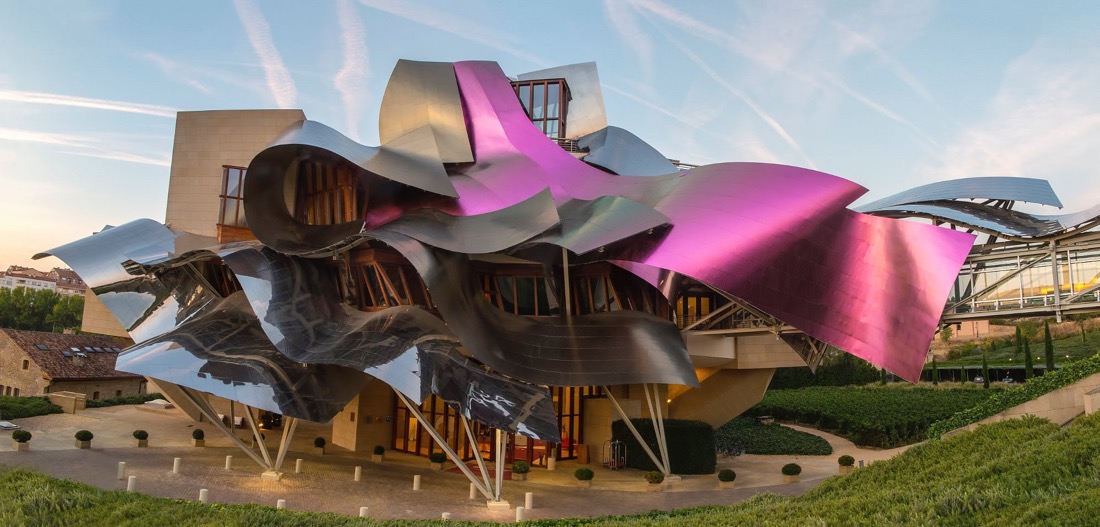
The wavy metal canopies flow around the exterior, and aside from framing the views and providing shade, they have become the signature of the building, and in many ways the new identity of "Vinos de los Herederos del Marqués de Riscal, S.A.".
The titanium skin was made in Japan by Nippon Steel Corporation and coloured in Spain. It is reported that Gehry wanted to link the building with the landscape and the local wine-growing tradition, and this explains his choice of the rich hues.
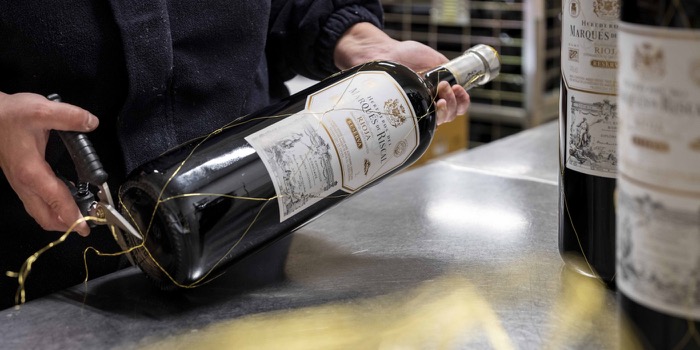
According to Gehry, the building's exterior reflects the colours of wine, with the pink tinted titanium panels representing the burgundy hues of Rioja wines. The silver-like mirror-finished stainless steel is meant to be the foil that covers the neck and cork, and gold represents the zig-zagging mesh that covers all Marques de Riscal bottles.
What is truly impressive is the way the canopies change colour depending on the seasons, the weather, and the time of day, …

Others see the branches and leaves of a grapevine …
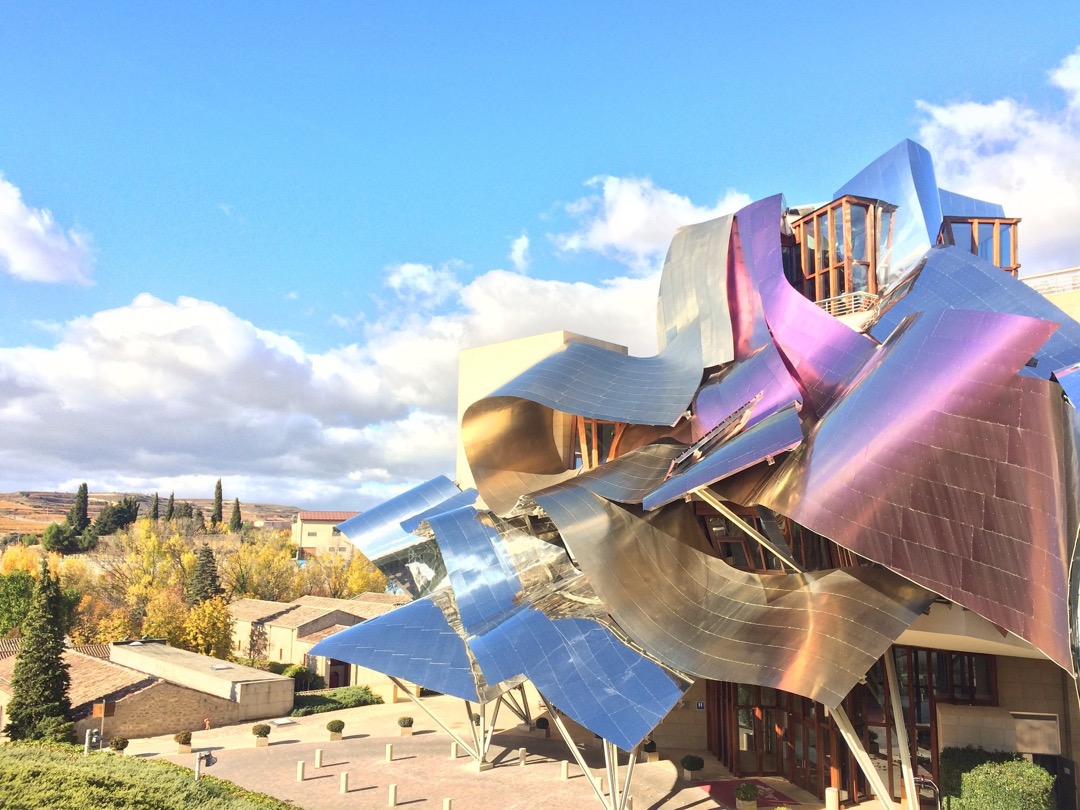
Many see a flamenco dancer's dress in motion, or is it the cascade of a waterfall …



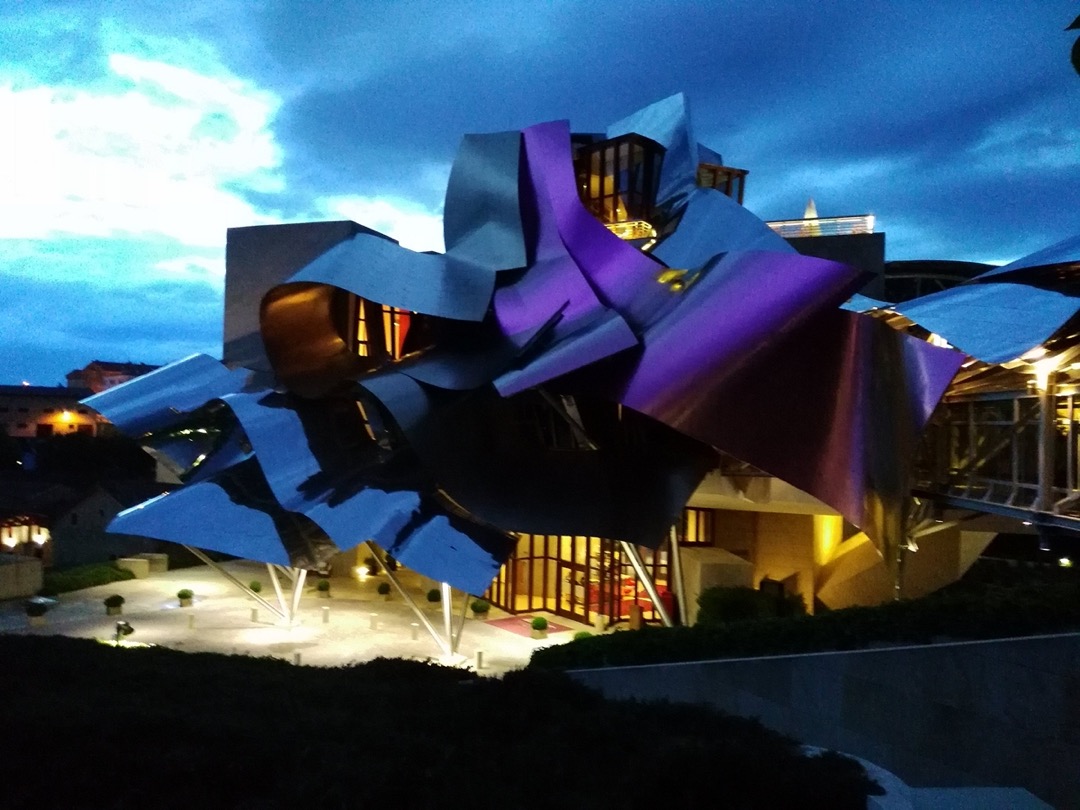
And finally, what about an alien spacecraft unfolding it's wings, ready to take-off in the evening sky …
